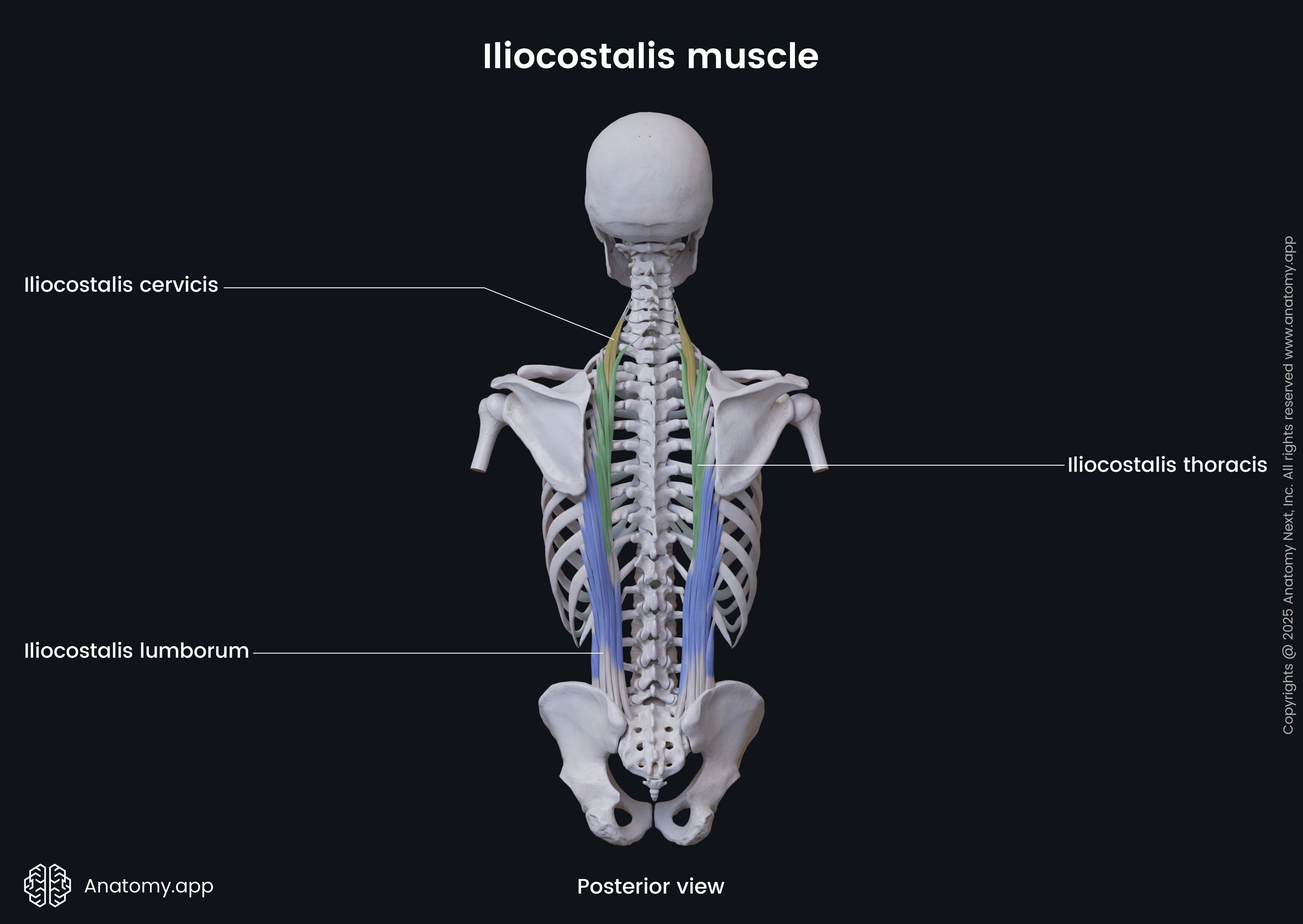- Anatomical terminology
- Skeletal system
- Joints
- Muscles
- Head muscles
- Neck muscles
- Muscles of upper limb
- Thoracic muscles
- Muscles of back
- Superficial back muscles
- Intermediate back muscles
- Deep back muscles
- Superficial layer
- Intermediate layer (Erector Spinae)
- Deep layer (Transversospinales)
- Deepest layer
- Muscles of lower limb
- Heart
- Blood vessels
- Lymphatic system
- Nervous system
- Respiratory system
- Digestive system
- Urinary system
- Female reproductive system
- Male reproductive system
- Endocrine glands
- Eye
- Ear
Iliocostalis
The iliocostalis (Latin: musculus iliocostalis) is a deep back muscle that runs along the length of the spine and lies lateral to the longissimus. It is one of the three muscles forming the erector spinae muscle complex - the most powerful extensor of the back. Besides the iliocostalis, the erector spinae is also formed by the longissimus and spinalis muscles. The erector spinae muscles lie in the intermediate layer of the deep back muscles. The iliocostalis muscle has three parts according to their origin - iliocostalis cervicis, iliocostalis thoracis and iliocostalis lumborum.

Iliocostalis cervicis
| Iliocostalis cervicis | |
|---|---|
| Origin | 3rd - 6th rib angles |
| Insertion | Transverse processes of C4 - C6 vertebrae |
| Action | Bilateral contractions - extension of cervical spine Unilateral contractions - ipsilateral lateral flexion of cervical spine |
| Innervation | Lateral branches of dorsal rami of cervical spinal nerves |
| Blood supply | Vertebral, deep cervical and occipital arteries |
Origin
The muscle fibers of the iliocostalis cervicis originate from the third to sixth rib angles.
Insertion
The iliocostalis cervicis inserts on the transverse processes of the fourth to sixth cervical vertebrae (C4 - C6).
Action
Muscle contractions on both sides (bilateral contractions) extend the cervical spine. Contractions on one side (unilateral contractions) provide lateral flexion of the cervical spine to the same side (ipsilateral). However, the iliocostalis cervicis is a muscle with very little force capacity.
Innervation
The iliocostalis cervicis is innervated by the lateral branches of the dorsal rami of the cervical spinal nerves.
Blood supply
The iliocostalis cervicis receives oxygenated blood via the occipital, deep cervical and vertebral arteries. The occipital artery is a branch of the external carotid artery, while the deep cervical artery arises from the costocervical trunk. And finally, the vertebral artery branches off the subclavian artery.
Iliocostalis thoracis
| Iliocostalis thoracis | |
|---|---|
| Origin | 7th - 12th rib angles |
| Insertion | 1st - 6th rib angles, transverse process of C7 vertebra |
| Action | Bilateral contractions - extension of thoracic spine Unilateral contractions - ipsilateral lateral flexion of thoracic spine |
| Innervation | Lateral branches of dorsal rami of thoracic spinal nerves |
| Blood supply | Dorsal branches of posterior intercostal and subcostal arteries |
Origin
The iliocostalis thoracis muscle fibers originate from the seventh to twelfth rib angles.
Insertion
The iliocostalis thoracis inserts on the angles of the first to sixth ribs. Also, some fibers attach to the transverse process of the seventh cervical vertebra (C7).
Action
Muscle contractions on both sides (bilateral contractions) extend the thoracic spine. Contractions on one side (unilateral contractions) provide lateral flexion of the thoracic spine to the same side (ipsilateral).
Innervation
The iliocostalis thoracis muscle is innervated by the lateral branches of the dorsal rami of the thoracic spinal nerves.
Blood supply
The iliocostalis thoracis is supplied by the dorsal branches of the posterior intercostal and subcostal arteries. The posterior intercostal arteries arise from the superior intercostal arteries and thoracic aorta. The subcostal artery is a branch of the thoracic aorta.
Iliocostalis lumborum
| Iliocostalis lumborum | |
|---|---|
| Origin | Lateral crest of sacrum, medial aspect of iliac crest, thoracolumbar fascia |
| Insertion | 5th - 12th rib angles, transverse processes of L1 - L4 vertebra, adjacent thoracolumbar fascia |
| Action | Bilateral contractions - extension of lumbar spine Unilateral contractions - ipsilateral lateral flexion of lumbar spine |
| Innervation | Lateral branches of dorsal rami of lumbar spinal nerves |
| Blood supply | Branches of lumbar and lateral sacral arteries |
Origin
The iliocostalis lumborum arises from the lateral crest of the sacrum, medial aspect of the iliac crest and the thoracolumbar fascia.
Insertion
The iliocostalis lumborum muscle inserts on the fifth to twelfth rib angles, transverse processes of the first to fourth lumbar vertebrae (L1 - L4) and the adjacent thoracolumbar fascia.
Action
Muscle contractions on both sides (bilateral contractions) extend the lumbar spine. Contractions on one side (unilateral contractions) provide lateral flexion of the lumbar spine to the same side (ipsilateral).
Innervation
The iliocostalis lumborum is innervated by the lateral branches of the dorsal rami of the lumbar spinal nerves.
Blood supply
The iliocostalis lumborum receives arterial blood supply from the dorsal branches of the lumbar and lateral sacral arteries. The lumbar arteries are branches of the abdominal aorta, while the lateral sacral arteries arise from the internal iliac arteries.